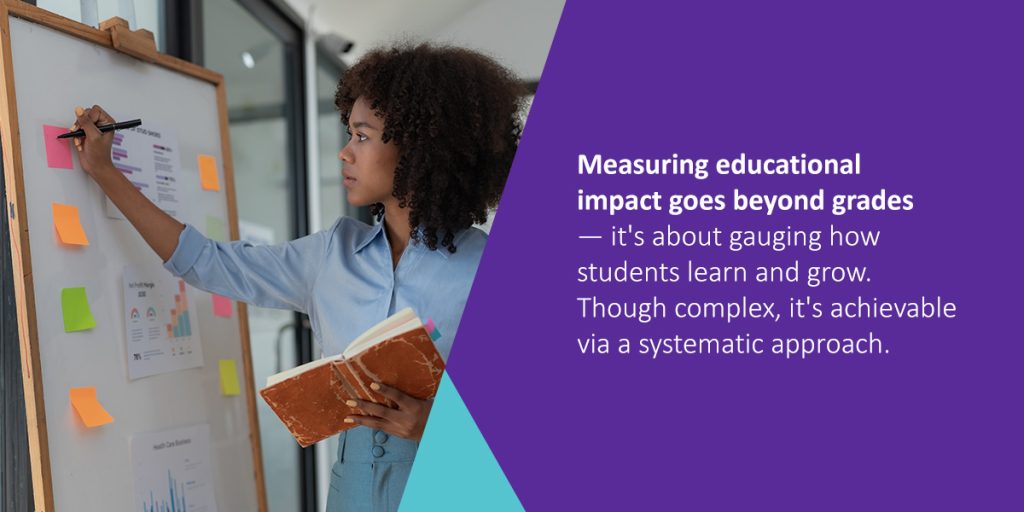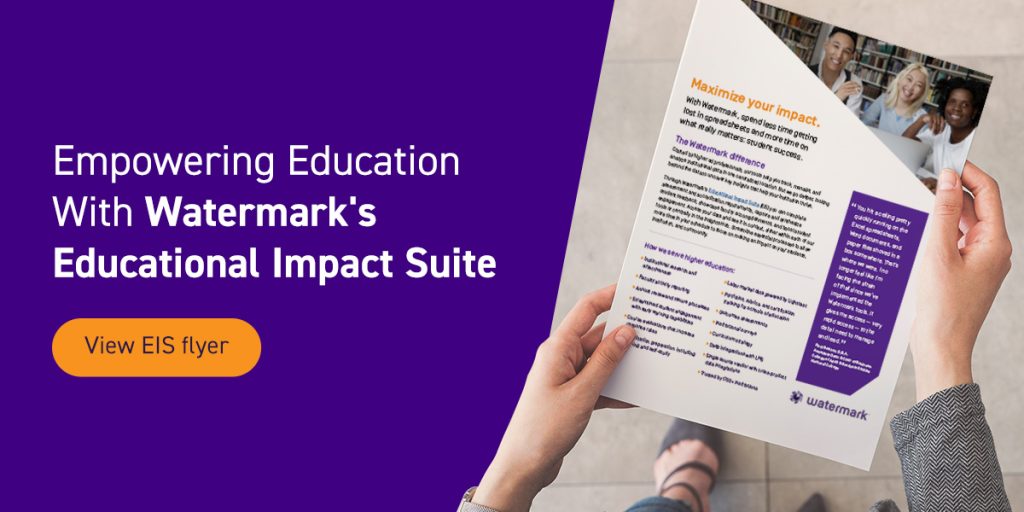



Effectively understanding educational impact can help university administrators make wise decisions for the future of their institution. But what is educational impact and what are its ramifications for students? Learn more about educational impact and how higher education can measure it to ensure student success.
Educational impact is the effect various higher education initiatives have on a variety of factors, including retention, academic performance, technology implementation, and career readiness — among other factors.
Along with other ongoing education trends, educational impact looks beyond traditional assessment measures to compile a holistic view of student success, including:
Higher education aims to measure impact, improve offerings, and prepare students for the future.
Measuring educational impact is a strategic imperative that drives improvement in higher education. Institutions need to assess their initiatives to gain insights, guide decision-making, improve teaching, and boost learning. Educational impact helps institutions with:
Measuring educational impact equips decision-makers with data-driven insights. Evaluating curriculum, improving teaching practice, and allocating resources is key to progress.
Educators use educational impact measurement to understand student learning and optimize success. Data on engagement, outcomes, and knowledge retention helps them improve teaching.
The world is evolving and higher education must keep pace. Measuring educational impact helps institutions align curricula with real-world demands, ensuring graduates succeed. This alignment benefits students and enhances the institution’s reputation and relevance.
Measurement of educational impact facilitates evidence-based continuous improvement. Institutions can track trends, watch progress, and test initiatives’ effectiveness over time. This iterative process allows for fine-tuning educational strategies, enhancing student outcomes.
Educational impact measurement extends beyond campuses, helping institutions understand their contribution to society. They can show their students’ role in social progress and economic development by analyzing graduates’ achievements and their effect on industries.
Educational impact data fosters a culture of innovation and adaptation within institutions. Institutions can spot improvement opportunities, try new teaching methods and use new tech to meet students’ needs. Impact measurement is essential for achieving excellence — these insights aid decision-making, teaching, and understanding of the influence on students and society.
In today’s competitive job market, it’s essential for institutions to help students learn new skills and hone existing ones so they can stand out from the competition and secure a job. Educational impact measures how students find meaningful employment and build unique skills and qualifications.
Higher education institutions must work to empower students to achieve success. Measuring educational impact includes gauging how expanding access to accessibility and diversity, equity, and inclusion initiatives ensures students have the tools they need. Empowered students have improved academic performance and contribute to fostering a culture of understanding and respect at an institution.

Measuring educational impact goes beyond grades — it’s about gauging how students learn and grow. Though complex, it’s achievable via a systematic approach. By following these steps, educational institutions can start measuring impact:
The first step towards measuring educational impact is setting clear and well-defined goals. Educators and institutions need to identify what they intend students to achieve. This could involve defining learning outcomes, skill acquisition, and character development. By establishing these objectives, institutions provide a roadmap to measure success.
For example, proficiency scales offer meaningful insights into student performance. Your institution should have a comprehensive plan to assess proficiency scales and use that data to interpret the efficacy of teaching methods and resources.
Gathering relevant data is essential to assess educational impact. Data like test scores, projects, class participation, surveys, and peer assessments give insight into student progress and involvement. Combining quantitative and qualitative data provide a complete view of educational impact.
Institutional surveys are just one source of valuable information higher education institutions collect. Using course evaluation software can help your school ask the right questions and turn student responses into actionable insights.
Compare data to predefined objectives, analyzing student performance beyond numbers to measure results. Are students meeting the goals set for them? Which areas are excelling and which ones need improvement? This process offers insights into teaching methods and curriculum design.
For example, data on student presentations, written assignments, and peer interactions in class can show progress in communication skills.
After thoroughly comparing and analyzing educational impact data, institutions can adjust their approaches to better meet their goals. If insights from student performance metrics reveal challenges with new technology adoption in the classroom, higher education institutions can implement new training for faculty. If drop-out rates increase for certain student populations, exit surveys can help schools adjust their retention strategies.
Tracking students’ progress over time provides a holistic view of educational impact. Measuring how far students have come since their enrollment is key to long-term progress. For example, technology can help institutions track student progress across their journey to show trends throughout their entire enrollment.
Share findings and successes with the school community. Celebrate student achievements and highlight how far they’ve come. You can show the value of measuring educational impact and the importance of continuous improvement by showcasing how your institution achieves its goals.
Measuring educational impact is a continuous process — it’s all about monitoring data, adapting strategies, and refining approaches based on gained insights over time. Institutions embracing educational impact create an environment of continuous improvement.
Measuring educational impact is a driving force behind institutional growth and student success. Embrace Watermark’s Educational Impact Suite (EIS) to harness data for positive change. EIS is more than a collection of tools — it is a transformational approach to measuring and enhancing education. Use Watermark to ensure teaching methods resonate, align with accreditation, and drive improvement. Refer to the EIS flyer for an overview of solutions and data.






























































































































































































































































































































































































